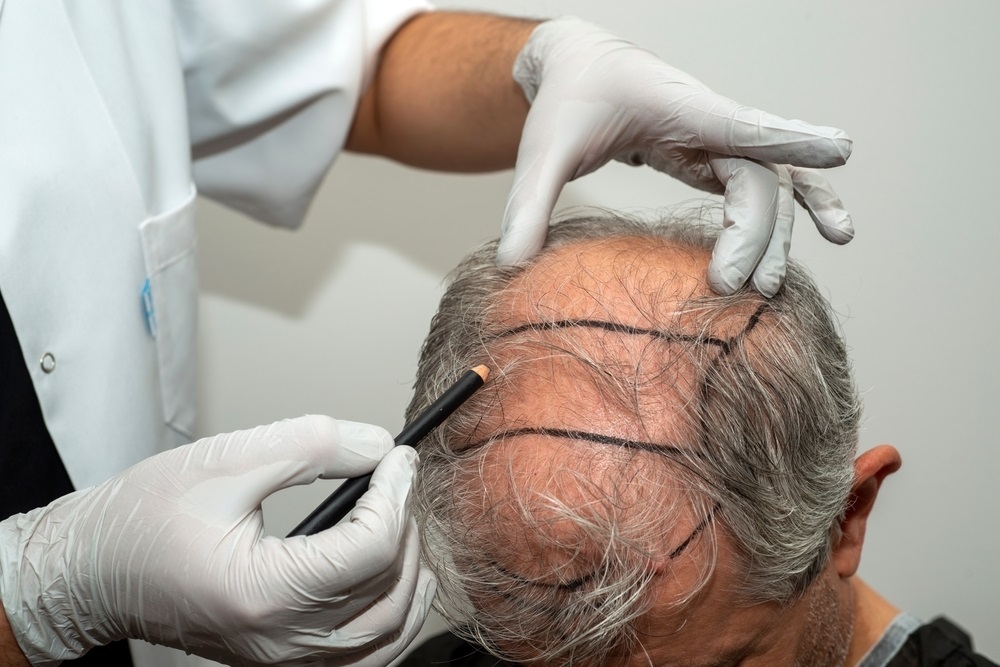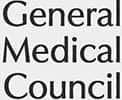
Androgenetic alopecia (AGA) is commonly referred to in men as male pattern baldness and impacts up to 50% of men by the age of 50. In this guide, we will explain the causes of male pattern baldness, men’s hair transplant surgical procedures and non-surgical treatments for hair loss. We aim to provide the information you need to know to make an informed decision about your treatment options for hair loss.
Male pattern baldness is the most common form of hair loss in men and research has found that genetics play a major role in its development. Male pattern baldness can start following puberty and the first telltale sign is often a receding hairline. Although men and women may experience hair loss, the androgen receptor (AR) gene has been linked to hair loss, specifically in men.
Research indicates that differences in the AR gene produce androgen receptors that have a greater response to androgens. This causes the receptors to be more active in hair follicles. How these genetic alterations raise the risk of hair loss in both men and women with androgenetic alopecia is still unknown.
Hair loss can occur on a temporary or permanent basis. In most cases other causes of hair loss in men and women are temporary and may be related to:
• Iron deficiency
• Illness
• Medication
• Stress and anxiety
• Thyroid disorders
• Hormones
• Weight loss.
Hair transplant procedures for men have become more common over the past few decades and can produce excellent results. Although hair transplant techniques are relatively well established and considered safe, it’s important to understand the options, potential risks, and side effects if you are considering hair implant surgery.
In the UK, hair transplant procedures for men are a popular option if you have male pattern baldness. Choosing the one that is best for you will depend on the extent of hair loss, your personal preferences and your desired outcome. Below, we explain how follicular unit extraction (FUE) hair transplants differ from follicular unit (FUT) hair transplants for men, as well as the advantages and disadvantages of each procedure.

The FUE procedure is a minimally invasive hair transplant technique that only requires local anaesthetic. During the procedure, either the individual follicles are extracted; this can be done manually using a handheld instrument that creates microscopic incisions or with a robotic device that does the same. A robotic FUE transplant is considered to be the most advanced technique which produces the most reliable results.
| Advantages | Disadvantages |
| Tiny incisions and no stitches | Less suitable for excessive hair loss |
| No linear scarring | More likely to require multiple sessions |
| Fast recovery time, typically in a few days | May produce lower-quality grafts, especially when done manually |
| Hair can be worn short at the back as the scars in the donor area are not detectable | Higher chance of loss of transplanted hair follicles due to the balding process |
| Reduced risk of infection, bleeding and other complications | Can result in thinner hair in the donor area |
FUT hair transplants are more invasive and require a long incision in the donor area of the scalp. Generally, this is performed under local anaesthetic with sedation if requested.
The procedure involves the removal of a strip of skin and tissue containing the hair follicles, which is usually between 0.5 to 1.5cm wide. The strip is then dissected into sections that contain individual follicles that are grafted into selected areas of the scalp where hair loss is occurring.
| Advantages | Disadvantages |
| More suitable for larger areas of hair loss | Can leave a visible scar that is noticeable when hair is short |
| Less likely to require repeat procedures | Typically requires the use of stitches. |
| Does not result in thinning hair at the donor site | Requires a longer recovery time of between 10 to 12 days. |
| Suitable for men with scalp laxity | A higher risk of infection, bleeding and associated complications |
| Typically produces a higher number of viable hair follicles for grafting | |
| Results tend to be more predictable and long lasting |
Hair transplants are classed as surgical procedures. As with all surgical procedures, there are several risks and complications associated with both FUE and FUT hair transplant procedures. Below is a list of the key complications associated with hair transplant procedures.
This list is not exclusive, and before committing to any surgical procedure, you should ask the doctor or surgeon performing the procedure for a full list of potential complications.
• Infection
• Necrosis
• Postoperative facial edema
• Graft dislodgement
• Necrotic patches
• Numbness or hypersensitivity (at the donor site)
• Keloid scarring.
The use of non-surgical treatments as an alternative to hair transplants to treat hair loss is a popular option, and various methods are available. Hair loss treatments shown effective in clinical trials are explained below.
Minoxidil: This is one of the three FDA-approved topical treatments approved in 1988 and comes in topical and oral formulas. For males with mild-to-moderate AGA, minoxidil was used as a first-line treatment. Multiple studies have established the benefits of topical minoxidil.
Side effects of topical minoxidil include:
• Irritant and allergic contact dermatitis (skin irritation)
• Pruritus (itching)
• Scalp inflammation
• Facial hypertrichosis (excessive hair growth)
Side effects of oral minoxidil include:
• Increased heart rate
• Weight gain
• Hypertrichosis (excessive hair growth on the face or body)
• Lower extremity oedema (swelling due to fluid buildup in legs).
Finasteride: Available in both oral and topical formulations, finasteride has been shown in clinical trials to promote hair growth and reduce hair loss. There is no standard formulation of topical finasteride and the dosage, which means it is difficult to predict the effectiveness of any specific formulation.
Side effects of topical finasteride include:
• Skin erythema (redness and pain)
• Contact dermatitis (skin irritation)
• Increased liver enzymes
• Nocturnal enuresis (nighttime incontinence)
• Testicular pain
• Headaches
• Presyncope (feeling light-headed)
• Oropharyngeal pain (pain in throat).
Side effects of oral finasteride include:
• Orthostatic hypotension
• Dizziness
• Erectile dysfunction
• Ejaculatory dysfunction
• Decreased libido
• Decreases sperm count.
Dutasteride: Available in an oral formulation, dutasteride has been shown in trials to be more effective than finasteride at stimulating hair growth.
Side effects of oral dutasteride include:
• Erectile dysfunction
• Ejaculatory dysfunction
• Decreased libido.
Low‐level laser therapy (LLLT): The most common way to administer LLLT at home is with combs, helmets, and caps, among additional devices. Two FDA-approved devices for the management of AGA are the Capillus® laser cap and the Hairmax® Lasercomb/Laserband. LLLT treatment has been shown to be effective in 10 clinical trials. One trial indicated the effectiveness of LLLT in combination with finasteride, whereas two trials demonstrated effectiveness when used in conjunction with topical minoxidil.
Side effects of LLT include:
• Acne
• Mild paresthesia (burning sensation)
• Dry skin
• Headaches
• Pruritus (itching).
Light‐emitting diode (LED) devices: Designed for home use, these devices have been shown to increase hair growth with no reported side effects.
Steroid injections: Injections of corticosteroid steroids directly into the scalp for hair loss treatment are known as off-label use. Multiple treatments of injections are normally required for six months.
Side effects of corticosteroid injections include:
• Acne
• Weight gain
• Increased risk of osteoporosis (weak bones).
Microneedling: Research indicates that microneedling can improve topical medication penetration and increase the thickness and density of hair. In clinical trials, topical minoxidil treatments combined with microneedling have also shown superior outcomes than minoxidil treatments in isolation.
Side effects of microneedling treatment include:
• Bruising
• Folliculitis (infected or inflamed hair follicles).
Platelet‐rich plasma (PRP): Treatment with PRP is most suited for people with early-stage androgenetic alopecia (AGA) when the hair follicles are still intact. The majority of patients in sixteen studies reported hair growth after PRP therapy, after three to four monthly treatments, followed by quarterly maintenance sessions. In clinical trials, PRP treatments, when used in conjunction with topical minoxidil, have also demonstrated better results than treatment with minoxidil alone.
Side effects of PRP treatment include:
• Mild bruising or swelling at the injection site.
PRP treatment is not suitable for people with:
• History of bleeding disorders
• Autoimmune disease
• Active infection of the scalp
• In conjunction with anticoagulant medication.
Regardless of the type of hair transplant you choose, there are some things that you should consider before you commit to any procedure. To get the best hair transplant in the UK, you need to find an experienced practitioner who has had training and experience performing this procedure.
You may not be aware that there is very little regulation of hair transplant procedures and who they can be performed by in the UK. The key requirement is the procedure must be performed by GMC registered doctors and the procedure must take place in a facility registered with the Care Quality Commission (CQC). Unfortunately, some clinics and practitioners offering FUE hair transplant procedures in the UK may not meet these requirements.
The simplest way to find out if your hair transplant is being performed by an appropriately trained, experienced, and qualified doctor is to check if they are a member of the British Association of Hair Restoration Surgery (BAHRS). You should also check if the clinic is CQC registered and find out what rating they have been awarded.
In the UK, a hair transplant procedure will vary in price depending on several factors. Prices will often be higher in certain areas, such as London, where clinics will typically have higher overheads due to higher rents, property prices and staff wages. Additional factors that will affect the cost of a hair transplant include:
• The type of hair transplant procedure being performed
• The training and experience of the doctor performing the procedure
• The number of grafts or hair follicles being transplanted.
According to guidance from the NHS, a hair transplant procedure can range in price from £1000 to £30000.
You should always receive a consultation with the doctor who will perform the hair transplant procedure prior to making any commitment or payments. During your consultation, the procedure options should be discussed, and you should be made aware of any associated risks and complications in easy-to-understand terms.
You should also ask:
1. What qualifications and training does the doctor have for performing the procedure?
2. How long have they worked at or been working from the clinic where your procedure will take place?
3. What’s the average number of hair transplant procedures they perform in a month?
4. How many procedures do they typically perform per day?
5. Have any patients experienced complications following the procedure in the past three months, and what were they?
6. How do you contact them if you experience any concerns or complications?
7. What to do if you can’t reach them and you have a concern?
8. When and how many follow-up appointments can you have?
9. What is the policy on charges for subsequent procedures if you are not satisfied with the results?
10. What is included in the cost of the procedure?
At Harley Street MD, we provide platelet-rich plasma (PRP) hair treatment for male hair loss at our London clinic led by Dr Chia Tan. This hair loss treatment is a popular alternative to men’s hair transplant procedures in men.
Dr. Chai Tan’s expertise in men’s health and cosmetic medicine is evident from the numerous five-star Google ratings that he has received. In addition to being a GMC-registered doctor, Dr Tan who oversees all injectable PRP injections at Harley Street MD in London, is also a member of the following organisations:
• Royal College of Surgeons (MRCS)
• British College of Aesthetic Medicine (BCAM).
For the best possible outcome, you should start PRP hair treatment as soon as you have concerns about thinning hair or hair loss. The treatment is fast, and the risks of complications are very low when it is performed correctly in a hygienic environment.
In comparison to hair transplants, the cost of PRP men’s hair loss treatment is typically lower. PRP hair treatment at Harley Street MD costs £400 for a single session and £950 for three sessions.
At Harley Street MD you can receive a free consultation to find out more about PRP treatment for hair loss and if you are a suitable candidate. If for any reason the procedure is not appropriate for you we will advise you why.
The research and study references we used, in addition to our internal research, are all referenced here; most of them have an external link to the scientific publication. We work hard to bring you the most recent, impartial, factual and evidence-based information to help you make informed decisions.
• Male pattern baldness: What you need to know. From: Medical News Today
• Ho CH, Sood T, Zito PM. Androgenetic Alopecia. [Updated 2024 Jan 7]. In: StatPearls [Internet]. Treasure Island (FL): StatPearls Publishing; 2024 Jan. From: NIH
• Asfour L, Cranwell W, Sinclair R. Male Androgenetic Alopecia. [Updated 2023 Jan 25]. In: Feingold KR, Anawalt B, Blackman MR, et al., editors. Endotext [Internet]. South Dartmouth (MA): MDText.com, Inc.; 2000. From: NIH
• Hair loss. From: NHS
• Hair Transplant. From: NHS
• Dua A, Dua K. Follicular unit extraction hair transplant. J Cutan Aesthet Surg. 2010 May;3(2):76-81. doi: 10.4103/0974-2077.69015. PMID: 21031064; PMCID: PMC2956961. From: NIH
• Guide to FUT Hair Transplant: Benefits, Procedure & Recovery. From: ISHRS
• Regulation. From: BAHRS
• Nestor MS, Ablon G, Gade A, Han H, Fischer DL. Treatment options for androgenetic alopecia: Efficacy, side effects, compliance, financial considerations, and ethics. J Cosmet Dermatol. 2021 Dec;20(12):3759-3781. doi: 10.1111/jocd.14537. Epub 2021 Nov 6. PMID: 34741573; PMCID: PMC9298335. From: NIH
• Ganjoo S, Thappa DM. Dermoscopic evaluation of therapeutic response to an intralesional corticosteroid in the treatment of alopecia areata. Indian J Dermatol Venereol Leprol. 2013 May-Jun;79(3):408-17. Doi: 10.4103/0378-6323.110767. PMID: 23619446. From: NIH
• Yasir M, Goyal A, Sonthalia S. Corticosteroid Adverse Effects. [Updated 2023 Jul 3]. In: StatPearls [Internet]. Treasure Island (FL): StatPearls Publishing; 2024 Jan-. From: NIH







